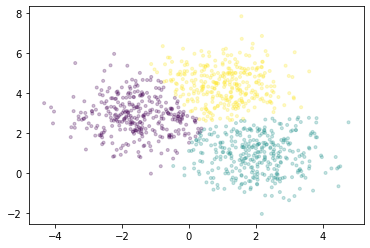Dask 用于机器学习
目录
实时 Notebook
您可以在 实时会话 中运行此 notebook 
Dask 用于机器学习¶
这是一个高级概述,演示了 Dask-ML 的一些组件。请访问主要的 Dask-ML 文档,参阅 dask 教程 notebook 08,或探索其他一些机器学习示例。
[1]:
from dask.distributed import Client, progress
client = Client(processes=False, threads_per_worker=4,
n_workers=1, memory_limit='2GB')
client
[1]:
客户端
Client-12a6896d-0de0-11ed-9ba6-000d3a8f7959
| 连接方法: Cluster object | 集群类型: distributed.LocalCluster |
| 仪表盘: http://10.1.1.64:8787/status |
集群信息
LocalCluster
ced599b8
| 仪表盘: http://10.1.1.64:8787/status | 工作节点 1 |
| 总线程数 4 | 总内存: 1.86 GiB |
| 状态: 运行中 | 使用进程: False |
调度器信息
调度器
Scheduler-60443685-4058-48d1-ba10-996f80c21c06
| Comm: inproc://10.1.1.64/7078/1 | 工作节点 1 |
| 仪表盘: http://10.1.1.64:8787/status | 总线程数 4 |
| 启动于: 刚刚 | 总内存: 1.86 GiB |
工作节点
工作节点:0
| Comm: inproc://10.1.1.64/7078/4 | 总线程数 4 |
| 仪表盘: http://10.1.1.64:42349/status | 内存: 1.86 GiB |
| Nanny: None | |
| 本地目录: /home/runner/work/dask-examples/dask-examples/dask-worker-space/worker-0l66zwyz | |
分布式训练¶

Scikit-learn 使用 joblib 实现单机并行。这允许您使用笔记本电脑或工作站的所有核心来训练大多数估计器(任何接受 n_jobs 参数的估计器)。
或者,Scikit-Learn 可以使用 Dask 实现并行。这允许您使用 集群 的所有核心来训练这些估计器,而无需显著更改代码。
这对于在中等大小数据集上训练大型模型最有用。当搜索大量超参数时,或者使用包含许多独立估计器的集成方法时,您可能会拥有一个大型模型。对于过小的数据集,训练时间通常很短,集群范围的并行性没有帮助。对于过大的数据集(大于单机内存),scikit-learn 估计器可能无法处理(见下文)。
创建 Scikit-Learn 估计器¶
[2]:
from sklearn.datasets import make_classification
from sklearn.svm import SVC
from sklearn.model_selection import GridSearchCV
import pandas as pd
我们将使用 scikit-learn 创建一对小的随机数组,一个用于特征 X,一个用于目标 y。
[3]:
X, y = make_classification(n_samples=1000, random_state=0)
X[:5]
[3]:
array([[-1.06377997, 0.67640868, 1.06935647, -0.21758002, 0.46021477,
-0.39916689, -0.07918751, 1.20938491, -0.78531472, -0.17218611,
-1.08535744, -0.99311895, 0.30693511, 0.06405769, -1.0542328 ,
-0.52749607, -0.0741832 , -0.35562842, 1.05721416, -0.90259159],
[ 0.0708476 , -1.69528125, 2.44944917, -0.5304942 , -0.93296221,
2.86520354, 2.43572851, -1.61850016, 1.30071691, 0.34840246,
0.54493439, 0.22532411, 0.60556322, -0.19210097, -0.06802699,
0.9716812 , -1.79204799, 0.01708348, -0.37566904, -0.62323644],
[ 0.94028404, -0.49214582, 0.67795602, -0.22775445, 1.40175261,
1.23165333, -0.77746425, 0.01561602, 1.33171299, 1.08477266,
-0.97805157, -0.05012039, 0.94838552, -0.17342825, -0.47767184,
0.76089649, 1.00115812, -0.06946407, 1.35904607, -1.18958963],
[-0.29951677, 0.75988955, 0.18280267, -1.55023271, 0.33821802,
0.36324148, -2.10052547, -0.4380675 , -0.16639343, -0.34083531,
0.42435643, 1.17872434, 2.8314804 , 0.14241375, -0.20281911,
2.40571546, 0.31330473, 0.40435568, -0.28754632, -2.8478034 ],
[-2.63062675, 0.23103376, 0.04246253, 0.47885055, 1.54674163,
1.6379556 , -1.53207229, -0.73444479, 0.46585484, 0.4738362 ,
0.98981401, -1.06119392, -0.88887952, 1.23840892, -0.57282854,
-1.27533949, 1.0030065 , -0.47712843, 0.09853558, 0.52780407]])
我们将拟合一个 支持向量分类器,使用 网格搜索 来寻找超参数 \(C\) 的最佳值。
[4]:
param_grid = {"C": [0.001, 0.01, 0.1, 0.5, 1.0, 2.0, 5.0, 10.0],
"kernel": ['rbf', 'poly', 'sigmoid'],
"shrinking": [True, False]}
grid_search = GridSearchCV(SVC(gamma='auto', random_state=0, probability=True),
param_grid=param_grid,
return_train_score=False,
cv=3,
n_jobs=-1)
要正常拟合,我们会调用
grid_search.fit(X, y)
要使用集群进行拟合,我们只需要使用 joblib 提供的上下文管理器。
[5]:
import joblib
with joblib.parallel_backend('dask'):
grid_search.fit(X, y)
我们拟合了 48 个不同的模型,对应 param_grid 中的每个超参数组合,分布在集群中。此时,我们有了一个常规的 scikit-learn 模型,可用于预测、评分等。
[6]:
pd.DataFrame(grid_search.cv_results_).head()
[6]:
| mean_fit_time | std_fit_time | mean_score_time | std_score_time | param_C | param_kernel | param_shrinking | params | split0_test_score | split1_test_score | split2_test_score | mean_test_score | std_test_score | rank_test_score | |
|---|---|---|---|---|---|---|---|---|---|---|---|---|---|---|
| 0 | 0.267177 | 0.011928 | 0.030591 | 0.006284 | 0.001 | rbf | True | {'C': 0.001, 'kernel': 'rbf', 'shrinking': True} | 0.502994 | 0.501502 | 0.501502 | 0.501999 | 0.000704 | 41 |
| 1 | 0.263738 | 0.005183 | 0.028903 | 0.005411 | 0.001 | rbf | False | {'C': 0.001, 'kernel': 'rbf', 'shrinking': False} | 0.502994 | 0.501502 | 0.501502 | 0.501999 | 0.000704 | 41 |
| 2 | 0.193400 | 0.005858 | 0.018773 | 0.003098 | 0.001 | poly | True | {'C': 0.001, 'kernel': 'poly', 'shrinking': True} | 0.502994 | 0.501502 | 0.501502 | 0.501999 | 0.000704 | 41 |
| 3 | 0.196229 | 0.006628 | 0.018826 | 0.002250 | 0.001 | poly | False | {'C': 0.001, 'kernel': 'poly', 'shrinking': Fa... | 0.502994 | 0.501502 | 0.501502 | 0.501999 | 0.000704 | 41 |
| 4 | 0.378106 | 0.006729 | 0.037400 | 0.002586 | 0.001 | sigmoid | True | {'C': 0.001, 'kernel': 'sigmoid', 'shrinking':... | 0.502994 | 0.501502 | 0.501502 | 0.501999 | 0.000704 | 41 |
[7]:
grid_search.predict(X)[:5]
[7]:
array([0, 1, 1, 1, 0])
[8]:
grid_search.score(X, y)
[8]:
0.983
有关使用分布式 joblib 训练 scikit-learn 模型的更多信息,请参阅 dask-ml 文档。
在大型数据集上训练¶
scikit-learn 中的大多数估计器都设计用于内存中的数组。使用大型数据集进行训练可能需要不同的算法。
Dask-ML 中实现的所有算法都非常适用于大于内存的数据集,您可以将其存储在 dask 数组 或 数据框 中。
[9]:
%matplotlib inline
[10]:
import dask_ml.datasets
import dask_ml.cluster
import matplotlib.pyplot as plt
在本例中,我们将使用 dask_ml.datasets.make_blobs 生成一些随机的 dask 数组。
[11]:
X, y = dask_ml.datasets.make_blobs(n_samples=10000000,
chunks=1000000,
random_state=0,
centers=3)
X = X.persist()
X
[11]:
|
我们将使用 Dask-ML 中实现的 k-means 对点进行聚类。它使用 k-means||(读作:“k-means parallel”)初始化算法,该算法比 k-means++ 具有更好的扩展性。所有的计算,包括初始化期间和之后,都可以并行进行。
[12]:
km = dask_ml.cluster.KMeans(n_clusters=3, init_max_iter=2, oversampling_factor=10)
km.fit(X)
/usr/share/miniconda3/envs/dask-examples/lib/python3.9/site-packages/dask/base.py:1283: UserWarning: Running on a single-machine scheduler when a distributed client is active might lead to unexpected results.
warnings.warn(
[12]:
KMeans(init_max_iter=2, n_clusters=3, oversampling_factor=10)
我们将绘制一个点样本,根据每个点所属的簇进行着色。
[13]:
fig, ax = plt.subplots()
ax.scatter(X[::10000, 0], X[::10000, 1], marker='.', c=km.labels_[::10000],
cmap='viridis', alpha=0.25);

有关 Dask-ML 中实现的所有估计器,请参阅 API 文档。